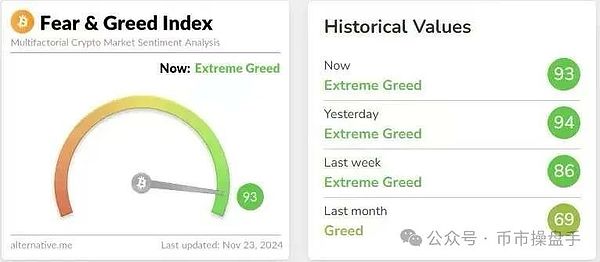From November 13th to November 14th, Binance's gainer list welcomed a group of long-lost faces, including DOT, FIL, SAND, MANA and other old kings of the previous bull market. After sitting on the bench for half a year, the holders of old altcoins finally felt the breath of the bull market. Driven by the collective surge of old altcoins, the money-making effect of this round of bull market reached a staged climax, and market sentiment continued to be in a state of extreme greed (93-94). In the past long period of time, the rebound of old altcoins was usually regarded as a signal that the stock positions and optimism had peaked. Therefore, the rebound of old altcoins also triggered market concerns about adjustments.

After countless roller coaster market tortures, many investors have formed a deep-rooted bear market mentality, so that every time the altcoin rises, the chips will rush to cash out. This is also the reason why the market is always highly vigilant about the altcoin's rebound. However, from two aspects, this round of altcoin market may be different from the past.
First, from the 13th to the 14th, when the price of altcoins rose by more than 20%, the liquidation scale of altcoin longs in the futures market was only 67 million US dollars, which shows that the main force's intention to pull the market is more to sweep up rather than force a short. At the same time, during the rise of altcoins, the futures positions and spot lending rates of altcoins did not rise significantly, which shows that the main short-selling forces still have no intention of building a large position.
Secondly, unlike the previous market increase through stock addition, November, when the market started, was the month with the largest scale and fastest issuance of USDT in the past year, which means that the driving force of the market rise mainly comes from the entry of incremental funds. Although the current altcoin market is more popular than on November 13, the daily market volume remains at around $300 billion, far below the peak of $556 billion on November 13. The main reason for this phenomenon is that Bitcoin entered a sideways consolidation phase during the rise of altcoins, thereby easing the pressure of liquidity competition in the market. Historically, when Bitcoin does not rise and altcoins are active, the bull market is often the most significant stage of money-making. For example, in March 2021, Bitcoin entered a range of fluctuations, and many currencies in sectors such as distributed storage, metaverse, and Layer2 saw a monthly increase of more than 10 times. If the fermentation of FOMO sentiment in each sector follows the path of "doubt-hesitation-delay-fear-buy", then the funds that are currently missing out on altcoins are only in the stage of hesitation.
As Bitcoin has repeatedly failed to hit $100,000, the market's expectations for its callback have gradually heated up, and some people even jokingly call the possible adjustment a "Thanksgiving discount." However, from the current point of view, the trend of Bitcoin is still completely dominated by bulls.
First, MicroStrategy, as the "first bull in the universe", currently still holds $3.7 billion in cash reserves (of which $3 billion is raised from convertible bonds), and there is still $15.3 billion in unused quotas for immediate issuance (as long as instructions are given to underwriters such as Barlake Capital and TD Securities, stocks can be sold immediately in the secondary market to raise funds), which means that there are a total of $19 billion in bullets available for increasing Bitcoin holdings in the future. At the same time, under the leadership of MicroStrategy, more and more institutions and entities around the world have begun to join the wave of Bitcoin configuration. According to Coindesk, in the past week, entities including MARA and MetaPlanet have purchased more than $1 billion in Bitcoin. As long as MSTR continues to buy Bitcoin, these entities will most likely continue to follow. Obviously, with sufficient long bullets, once Bitcoin is adjusted, it will inevitably trigger a long counterattack.
Secondly, data from SoSoValue shows that BlackRock Bitcoin Spot ETF options traded 354,000 contracts on the first trading day, with a nominal turnover of $1.86 billion. Among them, 288,700 were call options and 65,000 were put options. The call/put ratio was 4.44, and the market sentiment was almost overwhelmingly optimistic. Data shows that the option with the largest trading volume in the market is the long option expiring on January 17, 2024, with a price range of $55-60, corresponding to a Bitcoin price of $97,000-105,000. In other words, the market is still optimistic that Bitcoin will break through $100,000 before Trump takes office.
In short, although market sentiment is extremely greedy and technical indicators are seriously overbought, short selling is still not a wise choice.
In terms of operation, if DOT, ATOM, ICP, FIL, etc. are used as positions according to the suggestions in the previous article, the returns last week basically exceeded the market average. After the daily trading volume of 300 billion US dollars became the norm, the direct beneficiaries of the market are undoubtedly DEX and CEX. At present, platform coins such as UNI, DYDX, and BNB have not yet performed significantly, and using them as a bottom position to prevent missing out is also a good defensive strategy.
 JinseFinance
JinseFinance
 JinseFinance
JinseFinance JinseFinance
JinseFinance JinseFinance
JinseFinance JinseFinance
JinseFinance Weiliang
Weiliang JinseFinance
JinseFinance Hui Xin
Hui Xin JinseFinance
JinseFinance Future
Future Cointelegraph
Cointelegraph